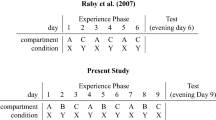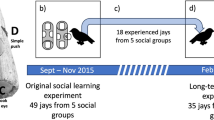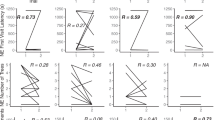Abstract
Social life has costs associated with competition for resources such as food1. Food storing may reduce this competition as the food can be collected quickly and hidden elsewhere2,3,4; however, it is a risky strategy because caches can be pilfered by others5,6,7,8,9. Scrub jays (Aphelocoma coerulescens) remember ‘what’, ‘where’ and ‘when’ they cached10,11,12,13. Like other corvids6,7,8,9,14, they remember where conspecifics have cached, pilfering them when given the opportunity, but may also adjust their own caching strategies to minimize potential pilfering. To test this, jays were allowed to cache either in private (when the other bird's view was obscured) or while a conspecific was watching, and then recover their caches in private. Here we show that jays with prior experience of pilfering another bird's caches subsequently re-cached food in new cache sites during recovery trials, but only when they had been observed caching. Jays without pilfering experience did not, even though they had observed other jays caching. Our results suggest that jays relate information about their previous experience as a pilferer to the possibility of future stealing by another bird, and modify their caching strategy accordingly.
This is a preview of subscription content, access via your institution
Access options
Subscribe to this journal
Receive 51 print issues and online access
$199.00 per year
only $3.90 per issue
Buy this article
- Purchase on Springer Link
- Instant access to full article PDF
Prices may be subject to local taxes which are calculated during checkout

Similar content being viewed by others
References
Zentall, T. R. & Galef, B. G. (eds) Social Learning. Psychological and Biological Perspectives (Lawrence Erlbaum Associates, London, 1998).
Shettleworth, S. J. in Behavioral Brain Research in Naturalistic and Semi-naturalistic Settings (eds Alleva, E., Fasolo, A., Lipp, H.-P. & Nadel, L.) 158–179 (Kluwer Academic, The Hague, 1995).
Vander Wall, S. B. Food Hoarding in Animals (Univ. Chicago Press, Chicago, 1990).
Clarkson, K., Eden, S. F., Sutherland, W. J. & Houston, A. I. Density dependence and magpie food hoarding. J. Anim. Ecol. 55, 111–121 (1986).
Gibb, J. A. Populations of tits and goldcrests and their food supply in pine populations. Ibis 102, 163–208 (1960).
Bednekoff, P. A. & Balda, R. P. Observational spatial memory in Clark's nutcrackers and Mexican jays. Anim. Behav. 52, 833–839 (1996).
Heinrich, B. & Pepper, J. W. Influence of competitors on caching behavior in the common raven, Corvus corax. Anim. Behav. 56, 1083–1090 (1998).
Bugnyar, T. & Kotrschal, K. Do ravens manipulate the others' attention in order to prevent or achieve social learning opportunities? Adv. Ethol. 36. 106 (2001).
Heinrich, B. Mind of the Raven (Harper Collins, New York, 1999).
Clayton, N. S. & Dickinson, A. D. Episodic-like memory during cache recovery by scrub jays. Nature 395, 272–278 (1998).
Clayton, N. S. & Dickinson, A. D. Scrub jays (Aphelocoma coerulescens) remember the relative time of caching as well as the location and content of their caches. J. Comp. Psychol. 113, 403–416 (1999).
Clayton, N. S. & Dickinson, A. D. Memory for the contents of caches by Scrub Jays. J. Exp. Psychol. Anim. Behav. Proc. 25, 82–91 (1999).
Clayton, N. S., Yu, K. & Dickinson, A. D. Scrub jays (Aphelocoma coerulescens) can form integrated memory for multiple features of caching episodes. J. Exp. Psychol. Anim. Behav. Proc. 27, 17–29 (2001).
Clayton, N. S., Griffiths, D. P., Emery, N. J. & Dickinson, A. D. Episodic-like memory in animals. Phil. Trans. R. Soc. Lond. B 356, 1483–1491 (2001).
Goodwin, D. Further observations on the behaviour of the jay. Ibis 98, 186–219 (1956).
Stevens, T. A. & Krebs, J. R. Retrieval of stored seeds by marsh tits (Parus palustris) in the field. Ibis 128, 513–515 (1984).
Hampton, R. R. & Sherry, D. F. The effects of cache loss on choice of cache sites in the black-capped chickadee. Behav. Ecol. 5, 44–50 (1994).
Baker, M. C. & Anderson, P. Once-pilfered cache sites not avoided by black-capped chickadees. Anim. Behav. 49, 1599–1602 (1995).
Hare, B., Call, J., Agnetta, B. & Tomasello, M. Chimpanzees know what conspecifics do and do not see. Anim. Behav. 59, 771–785 (2000).
Hare, B., Call, J. & Tomasello, M. Do chimpanzees know what conspecifics know? Anim. Behav. 61, 139–151 (2001).
Whiten, A. & Byrne, R. W. Tactical deception in primates. Behav. Brain Sci. 11, 233–244 (1988).
Suddendorf, T. & Corbalis, M. C. Mental time travel and the evolution of the human mind. Genet. Soc. Gen. Psychol. Monogr. 123, 133–167 (1997).
Heyes, C. M. Theory of mind in nonhuman primates. Behav. Brain Sci. 21, 101–148 (1998).
Clayton, N. S. & Dickinson, A. D. Motivational control of caching behaviour in the scrub jay, Aphelocoma coerulescens. Anim. Behav. 57, 435–444 (1999).
Acknowledgements
This work was supported by the National Institutes of Health, National Institute on Aging and Whitehall foundation grants to N.S.C. N.J.E was funded by a Medical Research Council programme grant to E. B. Keverne. We thank S. Hettige, D. Jennings and V. R. Metcalf for help in running the experiments. We also thank the University of California, Davis, for allowing us to conduct the first trials there and for providing the necessary facilities. We thank S. Baron-Cohen, E. B. Keverne, K. N. Laland, D. I. Perrett and C. J. Saldanha for comments on the manuscript. We are especially grateful to T. J. Bussey, A. Dickinson and N. J. Mackintosh for discussion and comments on the manuscript.
Author information
Authors and Affiliations
Corresponding author
Rights and permissions
About this article
Cite this article
Emery, N., Clayton, N. Effects of experience and social context on prospective caching strategies by scrub jays. Nature 414, 443–446 (2001). https://doi.org/10.1038/35106560
Received:
Accepted:
Issue Date:
DOI: https://doi.org/10.1038/35106560
This article is cited by
-
Canine perspective-taking
Animal Cognition (2023)
-
Social information used to elicit cache protection differs between pinyon jays and Clark’s nutcrackers
Behavioral Ecology and Sociobiology (2023)
-
Memory for own actions in parrots
Scientific Reports (2022)
-
Head-tracking of freely-behaving pigeons in a motion-capture system reveals the selective use of visual field regions
Scientific Reports (2022)
-
Type and amount of social experience influences individual face learning in paper wasps
Behavioral Ecology and Sociobiology (2022)
Comments
By submitting a comment you agree to abide by our Terms and Community Guidelines. If you find something abusive or that does not comply with our terms or guidelines please flag it as inappropriate.



